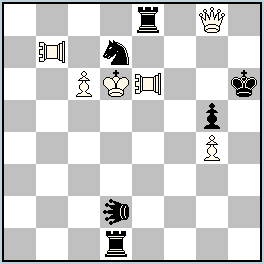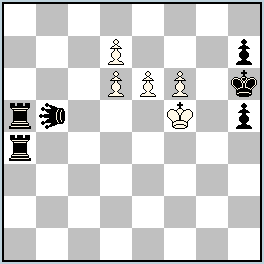|
|
Original Problems (page 132)Original fairy problems published during 2012 will participate in the informal tourney JF-2012. The site is mostly about fairies, but h# and s# are also welcomed for publication! Please send your problems to my e-mail: julia@juliasfairies.com Go to →List of Problems ; →Page 131 ; →Page 133 |
No.202 – hs#2 by Gani Ganapathi – Nice play of black LEO/R battery! (JV)
No.202.1 – hs#2 by Gani Ganapathi & K.Seetharaman – A new modification of No.202, with collaboration of K.Seetharaman – Meredith with play of black LEO/R battery and 3 white promotions! (JV)
Definitions:
LEO(LE): Moves as Queen, but captures only by hopping over a hurdle to any square beyond.
PAO(PA): Moves as Rook, but captures only by hopping over a hurdle to any square beyond.
|
No.202 Gani Ganapathi
India
original-23.12.2012
 hs#2 2 solutions (6+6)
b) White Sb7 (1 sol.) LEO d2 PAO b7, e6 Solution: (click to show/hide)
|
No.202.1 Gani Ganapathi & K.Seetharaman
India
original-26.12.2012
 hs#2 3 solutions (5+6)
LEO b5 Solution: (click to show/hide)
|
The diagrams are made on WinChloe and its Echecs font is used for Logo design



The twin is nothing unusual. What is unusual is one part having two solutions and the other only one solutions. In fact I have a publishable problem having this property but I am still trying unsuccessfully to get rid of the oddity.
As to your question whether the problem can be done without twinning, I think it can be done, though I dont have a ready suggestion.
[img]http://www.yacpdb.org/xfen/?K7/3P3p/5Ppk/6pp/8/b7/b7/(q3)r6[/img]
h#1.5
1…d7-d8=Q 2.Rb1-b4 Qd8-f8 #
1…d7-d8=S 2.Rb1-b3 Sd8-f7 #
1…d7-d8=LE 2.Rb1-b2 LEd8-h8 #
Excellent question Dmitri, what is a genuine helpselfmate?
Nice! This is getting very interesting !
As initially author wanted to show a Leo movement along the battery line, the following position seems to better match his idea.
[img]http://www.yacpdb.org/xfen/?R3(Q3)k2/2p1qpnn/8/3p1p2/5K2/8/8/8[/img]
h#1.5
1…LEe8-b8 2.Qe7-c5 LEb8-b4 #
1…LEe8-c8 2.Kf8-g8 LEc8-e6 #
1…LEe8-d8 2.Sh7-f6 LEd8*f6 #
This is very good, matching the original intention. I like especially the first variation ! Thanks Dmitri Turevski and Georgy Evseev for showing these excellent versions, and proving that our idea is really a helpmate scheme !
Now over to Nikola’s question “What is a genuine helpselfmate” ? One possible answer — If the play involves only one king, the other ready and in position to be mated, such schemes can be readily converted into helpmates.
I do not think the answer is so easy. Let’s take as an example Julia’s helpselfmate that got 2nd Prize in KoBulChess TT 2012 judged by Diyan Kostadinov. Black King is in position to be “almost mated”. Yet, the play has very helpselfmate feeling, far from helpmate. Still – is there anybody willing to try to transform it into good helpmate?
While the versions of Dmitry and Georgy are both good and interesting, one cant say that they have achieved a complete adaptation. Each of their versions shows part of the content only — Pelle movement or the promotions — but added other interesting elements.
So, I agree the answer is not easy. But I believe what I said is a good starting point.
I think that Seetharaman meaned – if wK is ready to get mated in hs# then it might be transformed into h# with bK ready to get mated. That’s what Georgy showed.
Of course, there are promotions and the answer is not so simple. But there’s a question about the economy. I have published few hs# with battery mates but the much easier way when a front piece does not participate in the mate (after firing the batterry) seemed unacceptable to me. I feel that in hs#, the economy should be more severely analysed than in h# or s#. Otherwise, why to bother with other genres if everything is acceptable in hs#?
In Russia there exists a recurring sluggish discussion concerning the comparison of directmates and selfmates. That is, if in a selfmate all mates are given by the same existing black battery, it is sometimes possible to remove the last halfmove together with this battery and have a directmate with the same tactical contents.
I think that this helpmate/helpselfmate situation is somewhat similar. Of course, it is the author who decides what to keep in problem and what is to be sacrificed and for what reason.
I tend to think that obvious fact the helpselfmates are much less prone to cooks than helpmates should lead to rendering of more difficult ideas and not to more strict economy requirements.
I agree Georgy, not strict economy requirements but serious analysis of economy in each problem, depending on the content.
3 mates by the same battery would be more interesting, for instance, if the front piece guards 3 different flights in mate.
hs#2 is often too short for complex ideas, so the functionality of pieces (at least the thematic ones) should be great.